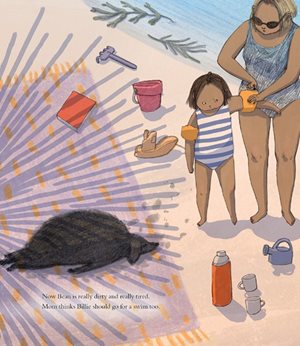This month’s Book Nook topic is...
Incorporating Pretend with Billie and Bean at the Beach


By Julia Hansson
|
Pretending has the power to bring a book to life. When children are supported to act out a story, it helps to build an understanding of the book on a deeper level. Pretending gets children thinking about important ideas such as the sequence of events in the story, the characters' motivations, and how problems are solved.
Let’s get started incorporating pretend!
|
Why We Chose This Book
In this story, Billie and her dog Bean are spending the day at the beach – but at first, Billie is not too happy to be there! With simple language and silly illustrations, the book presents several problems for Billie to resolve, which creates many fun opportunities for children to act out ideas.
The First Few Readings
The first time you read Billie and Bean, it’s important to keep the story moving. Have short conversations to help the child remember and understand the basic elements of the book. Lengthier conversations about what happened in the story can occur after reading the book, and when revisiting the story in the days to come.
You can support the child’s understanding by focusing on the basic elements in the story:
| CHARACTERS |
SETTING |
PROBLEM |
ACTION |
RESOLUTION |
| You can begin with the front cover. After reading the title, you could say, “This story is about Billie. She’s the main character.” |
Talk about where the story takes place. While still looking at the front cover, you could add, “This story takes place at the beach.” |
As you read, you will encounter the problems in this book. You could say, “Billie has a problem – she is feeling grumpy because she doesn’t want to be at the beach.” |
Highlight the actions that the characters take to solve problems. For example, “Billie uses a snorkel to make exploring the water more interesting.” |
Talk about the resolution to the problem. For example, “When Billie dived underneath the water with her snorkel, she felt happier because she saw lots of wonderful fish.” |
Later Readings
 After you have read the book with the child a few times, pretending by acting out parts of the story is a fun and motivating way to further support their understanding.
After you have read the book with the child a few times, pretending by acting out parts of the story is a fun and motivating way to further support their understanding.
When you pretend with the child, you can:
- Use props to help bring the story to life, such as sand buckets, sunglasses to use as a snorkel, or stuffed animals to use as underwater sea creatures
- Plan your roles – Talk about who will take on the role of Billie and who will take on the role of the mother. Another child or adult participating in the activity might pretend to be Bean, the jellyfish, or they may imagine they are another child who joins Billie at the beach
- Make sure you keep the book handy to refer to – this can be useful if the child forgets a part of the story, or if you’d like to re-read any particular part of the book
Then, it’s time to pretend by acting out some of the key events in the story!
For example, if the child is pretending to be Billie, they might dip their toes in the “water” and say, “Brrr!” You could respond by joining in and using a stuffed animal to say, “Zap! The jellyfish stung me in the cold water!” Then wait to see how the child responds. They may imagine a new direction to take the story, including different actions to resolve the problem, or you can return to the book together to talk about what Billie does next.
Keep the Conversation Going to Build Deeper Understanding
As you act out the story, you can make thinking-out-loud comments without placing pressure on the child to respond. For example, you could make comments like:
- “I’m wondering what else we will see in the water with our snorkels,” or
- “I’m thinking about what you will find in the sand.”
Asking open-ended questions is another way to support the child to keep the conversation going as they pretend. You can ask questions, such as:
- “My foot still hurts from the sting! What else should we try to fix it?” or
- “Where should we set up our umbrella?”
Every time you make a comment or ask a question, it’s important to wait and give the child time to respond. If the child does not respond after about 10 seconds, simply provide the answer yourself.
Bringing a story to life using pretend encourages the child to think more deeply about the book, its characters, and what happens as the story unfolds. The more you talk about the story by making comments and asking questions, the further the child’s understanding will go.
Happy reading!
We’ll let you know when a new Book Nook topic
has been posted!
Return to Book Nook